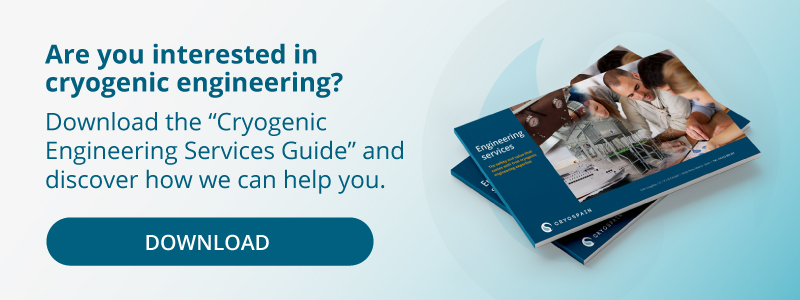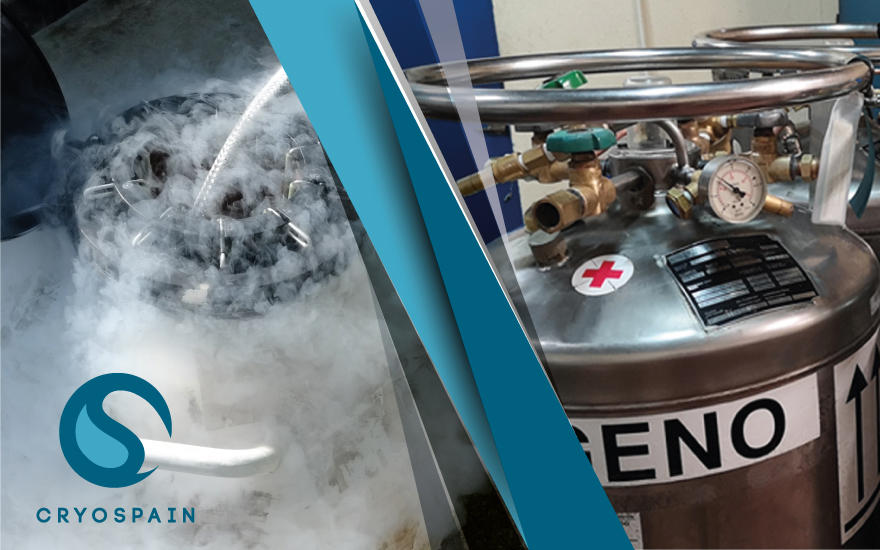A cryogenic dewar is both one of the main breakthrough inventions for the development of cryogenics in the 19th century and a crucial element today for storing certain common gases. We analyse what a dewar tank exactly is and what precautions must be taken in order to ensure its safety.
What is a cryogenic dewar?
A cryogenic dewar, dewar tank or dewar container is a vessel designed to store cryogenics (whose boiling points are lower than most substances). In order to do so, the dewar flasks present a vacuum space between the outside walls and the liquid stored inside, that acts as an insulator.
Thus, a cryogenic dewar can be simple (double walls and a space between them, such as household thermos for hot and cold drinks) or present other more complex elements like valves or gauges, built for other uses (such as a liquid nitrogen dewar or LN2 dewar).
Today, a cryogenic dewar is used to store, transport or provide on-demand cryogenic gases.
Related content: Cryospain: your Dewars and Rangers in expert hands
The history of cryogenic dewar: how they were created
The technology for using and producing cold has seen a tremendous surge in the latter half of the 20th century, and the invention of cryogenic dewar was one of the most important achievements to develop cryogenics.
Dewar flasks in fact are named after James Dewar, a Fullerian Professor of Chemistry at the Royal Institution, in London in 1877. In the midst of his research on cryogenics, he sought to understand heat transfer processes to achieve thermal insulation. He also wanted to comprehend the properties of fluids in order to produce cryogenic temperatures.
After a research that took him 15 years, he was able to invent what still constitutes the basis of the cryogenic dewar today: the silvered, double walled vacuum vessel, where he introduced powders such as silica, charcoal or lamp black, in order to act as vacuum space powders.
Thanks to this invention, he was able to develop a storage system for liquid hydrogen that was able to keep the liquified gas cold enough.
Common gases to store at a cryogenic dewar
The cryogenic dewars are characterized by their great adaptability. There are many different form on the market and each one has special specifications for the type of gas it stores. Some of the most common are:
- Cryogenic argon
- Liquid hydrogen
- Liquid helium
- Liquid nitrogen
- Liquid oxygen
- Liquid carbon dioxide
Related article: How do You choose the perfect cryogenic equipment manufacturer?
Safety and handling advices
There are a number of safety hazards related to cryogens and their storage.
- High pressures can be generated inside sealed dewars, generating a potential risk of explosion. In order to avoid this, some dewars allow the gas to escape through an open top, while others require pressure-relief valves.
- If a cryogenic dewar is left open for too long, it can generate condensation or freezing, potentially translating into contaminants, pressure build ups or risk or explosion.
- A gas escape might also mean asphyxiation hazard if the place is not properly ventilated. This is why containers must always be stored in a well-ventilated area.
- Information and caution labels must be installed in order to inform users of potential hazards.
- Technicians must wear the recommended PPE at all times when handling and filling the container, in order to minimize risks.
- Valve connections must be installed specifically to meet the needs for this sort of system
- Adaptors are not to be used
- The area should be a non-smoking one
- The installation of O2 monitors is recommended
- Valves must be opened slowly
- When the container must be manipulated or moved, preventive actions must be taken: two people should move it and wheels or specifically-designed dollies should be considered. At the same time, liquid containers shouldn’t be accompanied while transported in an elevator, and the container mustn’t be lifted from the protection ring.
As you could see, cryogenic dewars require frequent and exhaustive maintenance to comply with usage and safety regulations. In Cryospain we have a unit specialized in dewars maintenance that is operating since 2005 and we have repaired over 2000 units. If you have any questions, please contact us and our expert team will be happy to assist you.











 Contacte-nos
Contacte-nos